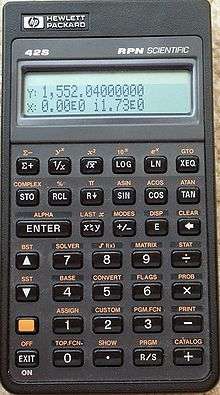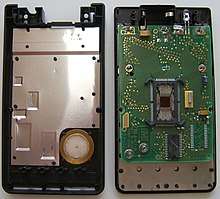HP-42S
The HP-42S RPN Scientific is a programmable RPN Scientific hand held calculator introduced by Hewlett Packard in 1988. It has advanced functions suitable for applications in mathematics, linear algebra, statistical analysis, computer science and others.
 The HP-42S | |
| Type | Programmable scientific |
|---|---|
| Manufacturer | Hewlett-Packard |
| Introduced | 1988 |
| Discontinued | 1995 |
| Calculator | |
| Entry mode | RPN |
| Precision | 12 display digits (15 digits internally),[1] exponent ±499 |
| Display type | LCD dot-matrix |
| Display size | 2 lines, 22 characters, 131×16 pixels |
| CPU | |
| Processor | Saturn (Lewis) |
| Programming | |
| Programming language(s) | RPN key stroke (fully merged) |
| Firmware memory | 64 KB of ROM |
| Program steps | 7200 |
| Interfaces | |
| Ports | IR (Infrared) printing |
| Other | |
| Power supply | 3×1.5V button cell batteries (Panasonic LR44, Duracell PX76A/675A or Energizer 357/303) |
| Weight | 6 oz (170 g) |
| Dimensions | 148×80×15mm |
Overview
Perhaps the HP-42S was to be released as a replacement for the aging HP-41 series as it is designed to be compatible with all programs written for the HP-41. Since it lacked expandability, and lacked any real I/O ability, both key features of the HP-41 series, it was marketed as an HP-15C replacement.
The 42S, however, has a much smaller form factor than the 41, and features many more built-in functions, such as a matrix editor, complex number support, an equation solver, user-defined menus, and basic graphing capabilities (the 42S can draw graphs only by programs). Additionally, it features a two-line dot matrix display, which made stack manipulation easier to understand.
Production of the 42S ended in 1995.[2] As this calculator is regarded amongst the best ever made in terms of quality, key stroke feel, ease of programming, and daily usability for engineers,[3] in the HP calculator community the 42S has become famous for its high prices in online auctions, up to several times its introduction price, which has created a scarcity for utility end users.
Specifications


Features
- All basic scientific functions (including hyperbolic functions)
- Statistics (including curve fitting and forecasting)
- Probability (including factorial, random numbers and Gamma function)
- Equation solver (root finder) that can solve for any variable in an equation
- Numerical integration for calculating definite integrals
- Matrix operations (including a matrix editor, dot product, cross product and solver for simultaneous linear equations)
- Complex numbers (including polar coordinates representation)
- Vector functions
- Named variables, registers and binary flags
- Graphic display with graphics functions and adjustable contrast
- Menus with submenus and mode settings (also custom programmable) that use the bottom line of the display to label the top row of keys
- Sound (piezoelectric beeper)
- Base conversion, integer arithmetic and binary and logic manipulation of numbers in binary, octal, decimal and hexadecimal systems
- Catalogs for reviewing and using items stored in memory
- Programmability (keystroke programming with branching, loops, tests and flags)
- The ability to run programs written for the HP-41C series of calculators
Programming
The HP-42S is keystroke-programmable, meaning that it can remember and later execute sequences of keystrokes to solve particular problems of interest to the user. The HP-42S uses a superset of the HP-41CX FOCAL language.
The HP-42S supports indirect addressing with which it is possible to implement a Universal Turing machine and therefore the programming model of the HP-42S can be considered Turing-complete.
Sample program
This is a sample program which computes the factorial of an input integer number (ignoring the calculator's built-in factorial function). The program consumes 18 bytes. No memory registers are used.
| Step | Instruction | Comment |
|---|---|---|
| 01 | LBLFAC | Start of program "FAC" |
| 02 | 1 | 1 is put into X, hence the value to be calculated upon (which was initially in X) is lifted (pushed) into stack register Y |
| 03 | LBL00 | Define label 00 |
| 04 | RCL×STY | Recall stack register Y and multiply with X |
| 05 | DSESTY | Decrement stack register Y and if not zero ... |
| 06 | GTO00 | ... go back to label 00 |
| 07 | END or RTN | Returns control (and result in X) to either the user or to a calling program. |
Legacy
In May 2017, SwissMicros released pre-production samples of an RPN calculator closely resembling the HP-42S, the DM42. The final product was released on the 9 December 2017. Even though slightly smaller (144×77×13 mm, 170 g) than the original HP-42S (148×80×15 mm, 170 g), the calculator comes with an additional top row of keys for soft menus, a keyboard layout supporting direct alpha character input, a much larger high-contrast display (Sharp low power transflective memory LCD with a resolution of 400×240, protected by Gorilla Glass) showing all four stack levels at once (configurable), ca. 75 KB usable RAM, a beeper, a callable real-time clock as well as an infrared port for HP 82240A/HP 82240B printer support and a USB interface (with Micro-B connector) emulating a FAT16-formatted USB mass storage device for easy program transfer and state backup / transfer as well as for firmware updates. The calculator, which comes in a stainless steel case with matte black physical vapor deposition (PVD) coating, supports keyboard overlays and is based on a modified version of Thomas Okken's GPLed Free42 simulator with Intel's decimal floating-point math library for higher precision (decimal128) running on an STM32L476RG processor (ARM Cortex-M4 core, 128 KB RAM, 1 MB internal flash) with another 8 MB of external QSPI flash (of which ca. 6 MB are available to users). It is powered by a CR2032 coin cell or via USB and clocked dynamically at 24-80 MHz. The DM42 is also the hardware basis for the community-developed WP 43S calculator,[5][6] a successor to the WP 34S.
See also
References
- HP-42S RPN Scientific Calculator - Owner's Manual (PDF) (1 ed.). Corvallis, OR, USA: Hewlett-Packard Co. June 1988. p. 3. 00042-90001. Archived (PDF) from the original on 2017-09-17. Retrieved 2017-09-17.
- "HP-42S". Museum of HP Calculators. Retrieved 2016-10-27.
- http://www.hpmuseum.org/cgi-sys/cgiwrap/hpmuseum/archv020.cgi?read=177373
- Hosoda, Takayuki (2007-10-10). "Upgrading the memory of the HP 42S to 32KB". Archived from the original on 2017-09-17. Retrieved 2011-08-12.
- Bonin, Walter (2019) [2015]. WP 43S Owner's Manual (PDF). 0.13 (draft ed.). ISBN 978-1-72950098-9. ISBN 1-72950098-6. Retrieved 2019-10-31. (314 pages)
- Bonin, Walter (2019) [2015]. WP 43S Reference Manual (PDF). 0.13 (draft ed.). ISBN 978-1-72950106-1. ISBN 1-72950106-0. Retrieved 2019-10-31. (271 pages)
Further reading
- HP-42S RPN Scientific Calculator - Owner's Manual (PDF) (1 ed.). Corvallis, OR, USA: Hewlett-Packard Co. June 1988. 00042-90001. Archived (PDF) from the original on 2017-09-17. Retrieved 2017-09-17.
- HP-42S RPN Scientific Calculator - Programming Examples and Techniques (PDF) (1 ed.). Hewlett-Packard. July 1988. 00042-90020, 00042-90019. Archived (PDF) from the original on 2017-12-19. Retrieved 2017-12-19.
- Strapasson, José Lauro; Jones, Russ (January 2010). An Alternative HP-42S/Free42 Manual (PDF). 0.7. Archived (PDF) from the original on 2017-09-17. Retrieved 2017-09-17.
- Horn, Joseph K. (2017-08-23) [1988-11-09]. "HP-42S Owner's Manual Addendum: Hidden Matrix Functions". Archived from the original on 2017-09-17. Retrieved 2017-09-17.
- "DM42 User Manual". 3.1. SwissMicros GmbH. 2017-12-19 [2016]. Archived from the original on 2017-12-19. Retrieved 2017-12-19.
External links
- HP-42S intro on hpcc.org
- HP-42S page on hpmuseum.org
- HP-42S resources on hp42s.com (defunct as of July 2017)
- HP-42S description on rskey.org
- HP-42S description on thimet.de
- Free42 for Android by Thomas Okken, an Open Source project.
- Okken, Thomas (2011-04-20). "Free42, A HP-42S Calculator Simulator". Retrieved 2011-08-12.